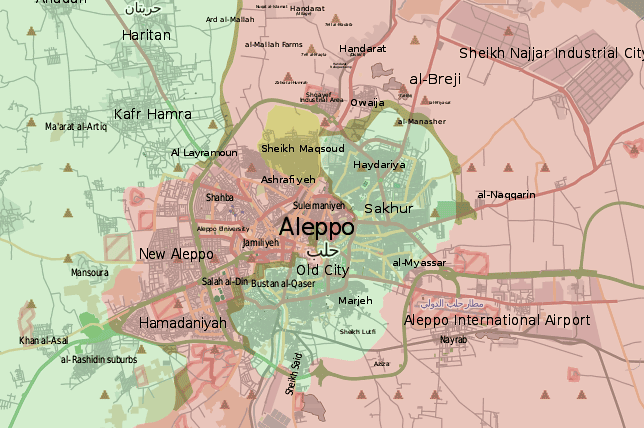


|
||
|
||
The northern Syrian city of Aleppo is one of the key battlegrounds of that country’s on-going civil war as well as the epicenter of the European refugee crisis. The most appropriate United States response to events in Aleppo has become a major foreign policy question among the candidates in this year’s U.S. presidential election.
Experts are now predicting that forces loyal to President Bashar al-Assad, backed by the Russian military, will take control of rebel-held eastern Aleppo within weeks. The image below illustrates the current state (as of 9 October 2016) of the conflict in Aleppo, depicting rebel-held regions in green and those under government control in red (see the full map on Wikipedia).
 BATTLE OF ALEPPO (2012 – Present) / The current state (as of 9 October 2016) of the conflict in Aleppo, depicting rebel-held regions in green and those under government control in red. Source: Wikipedia
BATTLE OF ALEPPO (2012 – Present) / The current state (as of 9 October 2016) of the conflict in Aleppo, depicting rebel-held regions in green and those under government control in red. Source: Wikipedia
Amidst all of this, the Syrian Communications and Technology Ministry announced this week that they had completed a new fiber optic line connecting the parts of Aleppo loyal to President Assad to the state telecom’s core network in Damascus, increasing available bandwidth for residents. It had previously been connected by a high-capacity microwave link.
From a BGP routing standpoint, this development was reflected by the disappearance of AS24814—appearance of AS24814 serving Aleppo was first reported in 2013. At 14:42 UTC (5:42pm local) on 10 October 2016, we saw the 14 prefixes announced by AS24814 shifted over to Syrian Telecom’s AS29256.
History of AS24814
In August of 2013, Dyn Research jointly published a blog post with the Washington Post documenting the loss of Internet service in Syria’s most populous city, Aleppo. Up until then, Internet service in Aleppo had been reliant on transit from Turk Telekom via a fiber optic cable traversing the rebel-held city of Saraqib to the west. This is the same Saraqib that was the site of suspected chemical weapons attacks months earlier. Fiber optic communications gear in Saraqib was disabled by rebels on 29 August 2013, resulting in the outage we reported, and service through Saraqib has never been restored.
In an effort to restore service to Aleppo, the Syrian Telecom (formerly known as STE) created an emergency fiber circuit to reach Turk Telekom via Idlib, Syria. The link was activated at 14:45 UTC on 8 October 2013 and it was then that AS24814 was first employed, designating this emergency communications link. (See report of this development in a 2013 blog post.)
While AS24814 (i.e., Internet service to Aleppo and surrounding areas) suffered numerous outages, service was lost for an extended period of time beginning in March 2015 when rebels took Idlib as part of the 2015 Idlib offensive. The fiber optic cables carrying service for AS24814 (Aleppo) were destroyed as a result of that offensive, resulting in a nearly 8-month outage.
AS24814 would only reappear on 8 November 2015 after Syria’s government military forces, aided by a new Russian bombing campaign, made the situation safe enough for government telecommunications engineers to reconnect Aleppo using a high capacity microwave link to the coastal city of Latakia, Syria.
Yesterday, that microwave link (along with the emergency Internet service designated by AS24814) was retired and replaced with a new fiber optic cable, providing substantially greater bandwidth and routed through Khanasir, a town located safely inside government-controlled territory.
In Conclusion
Internet service in rebel-held eastern Aleppo will not benefit from the new fiber optic cable as described here in this post. The remaining residents in this part of the city rely on a mix of small VSAT satellite terminals and unsanctioned microwave links into Turkey.
As reported last year, we speculated that the involvement of the Russian military in the fighting around Aleppo had sufficiently tilted the conflict in favor of the Assad regime to create the space needed for Syrian Telecom technicians to restore Internet service to the embattled city. The establishment of a new fiber optic cable servicing Aleppo marks further infrastructure consolidation in northern Syria by the government and, thanks to the Russian jets, may well presage the re-establishment of President Assad’s rule throughout the city.
A version of this report was first published in the Dyn Research blog.
Sponsored byVerisign

Sponsored byVerisign

Sponsored byWhoisXML API

Sponsored byIPv4.Global

Sponsored byRadix

Sponsored byDNIB.com

Sponsored byCSC
